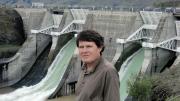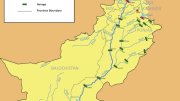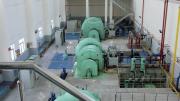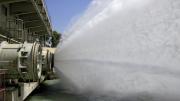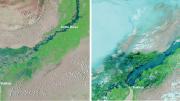In the little town of 5,000 where he now lives, John Briscoe holds the exalted title “master of the Todd Pond dam,” a tiny impoundment. He uses this role to introduce his students to the competing demands at the heart of water management.
“Everyone who lives on the pond likes the water to be kept high because it looks nice,” he explains. “But if you have a full lake and there is a lot of rain, water that overtops the dam will erode the base and you will lose your dam—which is a safety issue.” As the manager, therefore, Briscoe must monitor the weather. “If rain is coming, I go and take out a few boards to lower the level.” If the rain doesn’t materialize, a lot of swampy muck is exposed around the shoreline, and everyone asks him, “How come you lowered the dam?” The decision, he explains, was probabilistic.
Meanwhile, aquatic reeds grow and accelerate the accumulation of silt behind the dam, because “the natural course is to revert to being a swamp. But people don’t want to live on a swamp. They want to cut the trees around the pond so they can have a view; but that also speeds silting. How do you deal with human needs and environmental needs and safety? All of which, at a much lower level, are the issues of the great river systems in the world.”
Briscoe knows those great rivers well. In the world of water policy, he is the “damn dam guy” to some people, but in arid parts of the world, particularly in underdeveloped countries, he might be hailed as the “tamer of water”—if people on the street knew about his work.
Water issues are not just about scarcity or potability or floods, he explains—they are part religion, part politics, part civilization. “Take Three Gorges Dam,” he says. “From a distance it is perceived as the largest hydroelectric project in the world—which it is.” But what is the meaning of Three Gorges? “In Chinese history, the fall of emperors is associated in the popular mind with an inability to control floodwater: the emperor who does not control water will not last.” Dams are thus symbols of social order. “That symbolism, at least as much as the hydropower and flood control, is what Three Gorges is about”: the efficacy of the state. In India, where Briscoe lived for several years, the Ganges is deeply entwined in the country’s language, culture, history, and political order, he continues, as well as with such concerns as energy, health, agriculture, and the environment. “Water truly branches into all aspects of life.”
Infrastructure, Institutions, Innovation
Now a professor with appointments in the School of Public Health and the School of Engineering and Applied Sciences (SEAS), Briscoe grew up in South Africa, where his mother ran a day-care center and orphanage in the black township of Soweto. He was exposed to poverty and wealth: a social landscape that mirrored the country’s extremes of lush coastal regions ringing an arid but economically important interior—the center of vast mining operations. There, he formed “a view that was both personal and political about inequality and development and South African resources,” he says—“water being key to that.” Later, while living in the interior of Bangladesh, he experienced first-hand how a flood-protection and water project could make massive improvements in people’s lives in a place with no water or electricity. His subsequent career spent controlling water, whether for environmental or human purposes, has thus been something of a crusade, “never separate from my emotional, political, and personal life.”
Just before coming to Harvard in 2009, while working as country director for Brazil at the World Bank, for example, Briscoe authorized a small loan that typifies the kind of win-win solutions that he favors. In the state of Espírito Santo, the water utility that serves the capital city, Vitória, was having problems with very heavy runoff of sediments into its treatment plants, the result of agricultural development: a simple analysis showed that the cost of water treatment increased with the turbidity of the water entering the facilities. “This was a very practical argument, not about preserving the biodiversity of the earth or anything like that,” Briscoe reports. There was an equally practical solution: “If you work with the farmers upstream on better land-use practice, by investing X you can reduce the sediment loads coming down into the plants by Y.” The utilities “pay these farmers to manage their land in a different way”—improving agricultural productivity and preserving soil—“and it is actually much cheaper to do that than to treat all this sediment.”
Briscoe is, above all, a doer—he is McKay professor of the practice of environmental engineering and professor of the practice of environmental health. And there is plenty to do: water resources are finite, whereas demand increases as economies and populations grow. Climate change exacerbates water insecurity as glaciers melt and rainfall patterns shift. To address these concerns and to cultivate a new generation of “water intelligentsia,” he has launched the Harvard Water Security Initiative, which focuses on major challenges in countries around the world, including the ability to provide people with safe drinking water and food, to produce energy and sustain economic growth, and to enhance environmental quality.
In his academic context, far different from the World Bank role, Briscoe says, “How do you find ways in which you can both specialize and get very deep knowledge, but by the same token deal with issues as they really occur? Students are just dying for opportunities to work on problems in their full context.” He has spent his career “surfing between the thinking and the doing communities, the intersection between ‘practitioners who don’t read, and researchers who don’t practice.’” The water-security initiative aims to bridge this gap by creating “specialized integrators,” as Briscoe calls them, for water issues.
His students grapple with problems that “literally keep the leaders of many countries awake in the night”: rising demands for a highly variable resource; floods; droughts; climate change. The initiative is working in the Murray Darling basin (Australia), Pakistan, Brazil, and the Mississippi and Colorado river basins in the United States. Each basin is at very different stage of development, but all feature governments competing for water interests within a federal system (see “Across the Thinking-Doing Axis,” page 47). On the Mississippi, the issue is who gets flooded when the rain comes: New Orleans or a community behind a levee far upstream? In the American West, the first-order issues of secure potable water supplies have largely been solved by the construction of a vast number of dams, but allocating scarce water for agricultural use and for the environment in the nation’s most productive farming region is at times contentious. Brazil, on the other hand, has lots of water, mostly in the Amazon, but is nowhere near its potential in harnessing that resource for hydropower for a growing urban population, or for its booming role as a major agricultural exporter.
Briscoe brings an analytical framework to each of these basins, encouraging students to think about “three Is”: infrastructure, institutions, and innovation. “If you look at an arid basin like the Colorado,” he points out, “there is infrastructure [dams] to store three years’ supply of water. Historically, that is how they have dealt with variability. But in Pakistan, for example, the storage capacity is not three years but 30 days, so there is an enormous need for more infrastructure.”
Australia’s institutions are among the most advanced. (Cities have invested in desalinization plants to supply drinking water, as a kind of insurance policy that makes economic sense.) During a drought from 2000 to 2008, the Murray Darling basin in the country’s irrigated agricultural heartland suffered a 70 percent reduction in water availability. “Amazingly,” Briscoe reports, “they were able to produce the same aggregate agricultural output. They had lots of long-standing infrastructure [such as dams for storage], but they also had flexible institutions”—including a market for trading water rights as needed. Rice, for example, is a high-value crop when water is abundant and cheap. But when water is scarce, rice farmers who can’t grow rice still “make a killing because they have water entitlements” to sell to grape and fruit growers who produce much more value per unit of water. Then, when the price of water comes down, they grow rice again. The result is that the region produces the same value of goods—just not the same goods.
Australians have benefited as well from technological innovations such as drought-tolerant, genetically modified crops and the use of nanotechnologies in wastewater treatment and in desalinization. But expensive, high-reliability technological solutions to water problems won’t work everywhere. Water, as Briscoe often says, is a local issue. That is why he encourages dams in much of the developing world, but opposes new ones in places such as California, which has a lot of storage capacity already: “I’m a supporter of what makes sense.”
Pakistan’s Problems
Nowhere, perhaps, are water issues more complex than in Pakistan, where, last summer, four Harvard students—training in law, public policy, mechanical engineering, and environmental engineering, respectively—joined Briscoe and three students from Lahore University of Management Sciences to grapple with local problems.
Wedged between Afghanistan to the northwest and India to the southeast, the country was “created at the stroke of a British pen,” says Briscoe, by drawing a line through the middle of Punjab (“the land of the five rivers” in Urdu) province along largely religious lines. (Hindus ended up in India, Muslims in Pakistan). This geopolitical artifice matters because the headwaters of the Indus and five other rivers that drain into its basin were given to India. Water relations between the two countries have been governed since 1960 by the Indus Waters Treaty, brokered by the World Bank, which granted the flows of the three eastern rivers to India, and those of the three western rivers to Pakistan. (Briscoe was responsible for managing the bank’s role in the treaty while he worked there.)
That diplomatic solution nevertheless created the problem for Pakistan of getting its water from the western part of the country to the eastern agricultural zone. This was accomplished by constructing two large dams and enormous link canals, hundreds of miles long, that carry water flows 10 times those of the Thames. But almost half of the water that feeds these rivers comes from glacier- and snow-melt in the Himalayas. Climate change will eventually alter these flows. Some models predict that they will increase during the next couple of decades and then diminish by 30 to 40 percent in the next 100 years; others suggest the major change will be a seasonal shift in flows.
There are also problems of salinity (much of the lowland was once an ocean basin) and waterlogging from over-irrigating the land. These were analyzed during the 1960s by Harvard engineers engaged at the suggestion of then U.S. president John F. Kennedy and the invitation of Pakistan’s president, Ayub Khan. Their solution—the installation of diesel-powered tubewells to pump groundwater—simultaneously lowered the water table and leached salt out of the root zone. It also gave farmers a measure of independence: they no longer needed to rely on surface water from the Indus for all their irrigation needs. But groundwater resources are becoming scarce now, and the use of tubewells will likely need to be regulated, just as river flows are, to avoid running them dry.
A half-century after that earlier Harvard effort, Briscoe’s group of students met with farmers, business leaders, and civil servants; analyzed data; studied the legal accord that governs the sharing of water resources among the provinces; and made recommendations about how to manage those resources better in times of shortage and excess. Fundamental to their study was their collaboration, drawing on their specific areas of expertise to integrate legal analysis with technical understanding and policy recommendations. “That type of integration only happens when a group of people look at a single problem together,” says Briscoe. “The conversation between the lawyer and the engineer only becomes a conversation when it is about a specific set of issues.”
“Pakistan is bigger than England,” explains Laila Kasuri ’13, an environmental-engineering concentrator who hails from Lahore, but the country relies primarily on the Indus alone to supply water to farmers, who produce 25 percent of the country’s economic output. Through gravity-flow along the series of canals, the channeling of the Indus feeds the largest contiguous irrigation area in the world (54 million acres). Water is shared according to a “warabundi,” or time-allocation system. A tributary to a farmer’s plot might be opened, for example, for four hours every 10 days. But water sometimes doesn’t make it to the far reaches of this distribution system. That is in part because “most of the river’s flow comes in the summer months of June, July, and August,” explains Muhammad Hassaan Yousuf ’12, who studies mechanical engineering in SEAS. The other nine months, water is scarce and precious.
In some years, Pakistan—with 180 million people to feed and annual rainfall averaging less than 9.5 inches—suffers severe droughts and shortages of electrical power. (A particularly bad drought gripped the country between 1998 and 2002.) In other years, it is ravaged by floods. In 2010, says Erum Sattar, a member of the summer water-project team who is pursuing a doctorate at Harvard Law School, some 20 million people were displaced by a flood that covered one-fifth of the country’s land area. Two thousand people died. The flood destroyed homes, infrastructure, and crops, which led to higher food prices. The damage was estimated at $43 billion. Just a year later, a pattern of water shortages reasserted itself. These cycles of flood and drought, and the resulting poverty and food shortages, contribute to social dislocation. Meanwhile, the country’s population is projected to grow to between 300 and 320 million by 2050, Sattar says. Those people will need more water, and the food that water helps provide.
Trapping and Taming the Waters
The student project Briscoe set up in Pakistan is related to his work with the Asian Development Bank, for which he leads the analysis of water issues as part of a group with a “rather Orwellian name,” he notes: “Friends of Democratic Pakistan.” The funding countries are “not so friendly with the government of Pakistan, and Pakistan is not so democratic,” he points out, but the aim is a good one: to “stabilize the country both for their own good and for our good” by addressing its “major existential issues.”
His students visited six regions of Pakistan, meeting with stakeholders ranging from farmers to technical experts in flow modeling to private sector interests; Nestlé, for example, which collects milk from 190,000 farmers every day, has a vested interest in improving yields and therefore in more effective water management. The students also met with government officials involved in water regulation and visited sites of major importance to the country’s water infrastructure.
They saw first-hand that there is much room for infrastructure improvements, because Pakistan depends not only on one river, but on one major dam—the second largest in the world by structural volume. Tarbela Dam is managed for one purpose: agricultural irrigation. The group visited to gather data and study its operating rules—a subject they had learned about earlier in the summer during a trip to the Washington, D.C., headquarters of the U.S. Army Corps of Engineers.
Dams can be operated “to store water; to generate hydropower; or to mitigate flooding,” explains the Harvard team’s Yousuf—but a single dam cannot prioritize all three at once, and a dam’s flow parameters are chosen to serve the primary purpose for which it has been designated. In Pakistan, for example, “where there are two cropping seasons, one in summer and one in winter, most of the water flow comes in the summer, so you must store as much water as you can in that period” to have enough for the winter season. At Tarbela, that means filling the dam as much as possible during the summer. “By August,” Yousuf explains, “the dam should be full,” which is why “when the floods came in the summer of 2010, there was very little storage available to attenuate the flood peaks.” Because there are “no redundancies in the system,” he continues, “you can’t manage the dam for flood control during the summer. People need water for irrigation in the coming dry winter season.”
“The only solution,” says Kasuri, “is a very big dam.” Perhaps more than one. Pakistan clearly needs more agricultural-storage capacity, more flood-control capacity, and more electrical generating capacity. Only 14 percent of its economically viable hydropower potential has been developed (compared to more than 70 percent in advanced economies).
The country’s current plight, Briscoe says, is at least partly due to the fact that internationally, loans to developing countries for infrastructure projects have given way to funding for social goods such as healthcare and human rights. He considers that a mistake. No rich country has ever developed without first building its basic productive capacity, he argued in a recent interview with the journal Water Policy. “Not only is this the path that has been followed by all presently rich countries,” he said, “but it is the path followed by the countries who have, in recent decades, pulled their people out of poverty—like China, India, and Brazil.” (He has scant patience for critics of dam construction in developing countries. “The enlightened Californians” who argue for no dams in Pakistan “are on treacherous moral ground,” he argues within banking circles, “because they have no intention of following those recipes that they are telling everyone else to live by. I tell them, ‘Guys, for every Californian you have 9,000 cubic meters of water in storage. For every Pakistani, it is 30 cubic meters. Take yours down from 9,000 to 30, see how you do, and then decide if you want to tell them that.’ It drives me nuts—this telling other people how to live when you don’t live, couldn’t live, and have gotten rich by living in a completely different way. All they want is to be like you.”)
But lack of funding—the billions of dollars required to invest in solutions—is not the only problem in Pakistan. The country has no shortage of expertise (both Yousuf and Anjali Lohani ’08, a Nepalese student now in a master’s program at the Kennedy School, remarked on the talented water technocrats they met everywhere), yet the biggest source of the nation’s water problems, in Yousuf’s view, is “lack of political will.”
His observation is less a criticism of politicians than of the implementation of the legal framework governing the allocation of water, the group’s second focus of the summer, following the hands-on practicum. The Water Accord of 1991, a document of just two pages that was supposed to enhance cooperation among the provinces, has achieved much, the students wrote in an analysis later presented to government officials and representatives. But ambiguities of interpretation that govern the distribution of water during shortages have heightened mistrust, preventing or delaying the construction of mutually beneficial dams: no province, for example, wants to participate without knowing what its allocation from a new dam might be. And the accord could be more comprehensive in several other respects, says Sattar, the lawyer. For instance, it privileges agriculture, and even though that is sensible for a largely agrarian country, there are other national challenges for which the provinces need to find a workable mechanism. “Hydroelectric storage, for example, is not mentioned. Flood control is not mentioned.” Nor is there a mechanism for resolving conflicts between provinces in the courts, or through consensual negotiation and arbitration rather than by political mechanisms.
But the students by now have also learned that even if the bureaucratic impediments to development were removed, no engineering solution alone would solve every water problem in Pakistan. Dams and dikes and better floodplain management can help prevent sudden disasters, but then, downstream in the populous and flood-prone delta, the supply of essential sediment will be choked off. Yet there are steps that can be taken to improve human lives and also ensure that adequate flows of water reach the sea. “I don’t think any water system can ever be perfect,” says Kasuri. “You have to face new problems. Always, problems will remain.”
Across the Thinking-Doing Axis
The persistence of these challenges, made all the more acute by economic and population growth, requires increasingly sophisticated management. Briscoe’s water-security initiative, based at SEAS, aims to foster “interdisciplinary research which will enable policymakers to better understand the water threats they face and to identify new and better tools (technologies, policies, and institutions)” to address them.
“We are trying to create two things,” Briscoe says. “One is new knowledge and understanding.” There are already “really smart” people “grappling with the full complexity” of managing water issues in each of the five basins under study, “but they very seldom write anything.” Capturing that knowledge, “trying to bring out that tremendous richness of practice in a form that’s got academic and intellectual substance, almost like an oral history,” is one goal.
The other is training the “specialized integrators”—undergraduates, graduate, and postdoctoral students—who can simultaneously “drill deep down in their own disciplines” and work across the many areas of expertise required to address the challenge of water security. If anything, there are more Harvard faculty members working in water issues today than there were in the 1960s, during the heyday of the University’s earlier water program, he notes. Today’s students have access to pertinent courses in fields ranging from ecology to engineering, hydrology, religion, epidemiology, finance, history, business, chemistry, architecture, law, government, demography, and policy. Briscoe also aims to form partnerships between Harvard and major research institutions abroad. But at the heart of the initiative there is also direct engagement with the real world, reflected in a series of collaborative projects.
The Pakistan program was the first of these. Future water security initiative collaborations will involve similar, student-rich projects with other schools. Discussions have begun with McArthur University Professor Rebecca Henderson and with Forest Reinhardt, Black professor at the Business School, for example, on a “business and water” project. Already under way is a partnership with the Environmental Law Program directed by Cox professor of law Jody Freeman and Aibel professor of law Richard Lazarus to study the management challenges presented by major rivers in countries with strong federal governments. This year-long “water federalism” project encapsulates many of the ideals of the water security initiative. It involves a good-sized group of students, 30 in all, from a wide range of disciplines (engineering, law, public health, physics, chemistry, policy, and economics) working together in teams with “thinking practitioners” from five iconic river basins: the Colorado and the Mississippi in the U.S., the Murray Darling in Australia, the São Francisco in Brazil, and the Indus in Pakistan. The five student teams—six students per team—have been preparing this fall to spend the January term in their respective basins, where they will use their specialized skills to examine local issues through different lenses—policy, engineering, and hydrological, as well as constitutional, legal, environmental, and political—and consider how local experts have addressed successive challenges. During the spring semester, the students will focus on preparing papers for an April conference in Cambridge, at which they will work with the practitioners to draw lessons for both practice and research. Every basin has its own challenges and is at a different point in a long-term cycle of engineering and management solutions that have evolved as “challenge, response, new challenge, new response,” in Briscoe’s words. Quoting Coolidge professor of history David Blackbourn’s book on the Rhine, The Conquest of Nature, he notes, “Every solution is a provisional solution.”
“There are a lot of trade-offs you make” in the water management business, he continues, “but the idea that the untouched, natural way of life is the correct way of life is only for people who have never lived with nature. Nature is wonderful, but try living in a flood. Try living with droughts. Not so wonderful. That is how nature comes. She doesn’t come packaged with cows in green fields.”

